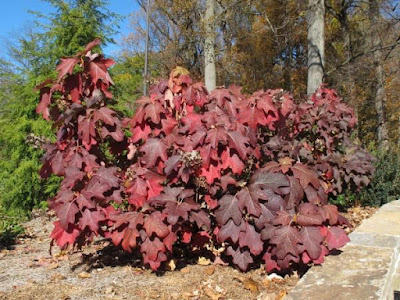 |
' Henry's Garnet 'Sweetspire is a native deciduous plant found in the southeastern United States. Itea virginica grows from about 6-8 feet tall, forming graceful, arching branches. In the early summer, Sweetspire blooms small, lightly fragrant white flowers on arching racemes.
 |
| Sweetspire photo by Sam Bahr, UMD |
The Oakleaf hydrangea, Hydrangea quercifolia, dominates the front of my home where I have let it grow a little too big on the corner. This plant has four season interest. The white flowers in late spring turn a mauve color in mid-summer. The fall leaf color sports shades of maroon, purple and red beneath the fading flowers. Added to that, the bark has a peeling nature in a lovely cinnamon color.
 |
| Oakleaf hydrangea fall colors |
 |
| Oakleaf hydrangea photo courtesy of University of Maryland |
Oakleaf hydrangea is a native to the southeastern United States. It thrives in light shade, shooting sprouts from underground which allows it to colonize easily if space is available. The deer have left it alone, unlike the other hydrangeas in my landscape. Oakleaf hydrangea will handle moist, though not wet, soil. The cone-shaped flower clusters are about 6-12 inches tall and about 5 inches wide at their base.
Serviceberry, Amelanchier canadensis, may fall more into the small tree category, as it grows 15 feet or more, but its natural form is a multi-stemmed shrub. Native to Maryland, it easily adapts to a broad range of soils, including clay and sand. The white flowers in spring and the fall berries are prized by native wildlife. Early flowers provide pollen and nectar to a wide variety of beneficial insects, including native bees. The berries provide for many birds, including Robins, Baltimore Orioles, Cedar Waxwings and Catbirds. The fall leaf colors are yellow, orange and red.
 |
| Serviceberry photo courtesy of Plant Finder as seen on our website |
Serviceberry grows in full sun to part shade in slightly acidic soil. It is an excellent alternative to the invasive Bradford pear.
Winterberry, Ilex verticillata, is a fall favorite for the berried stems that find all sorts of uses in fall and winter decorating. The deciduous holly loses its leaves in the next month or two, leaving branches of colorful red berries. Native to the eastern United States, Winterberry does very well in wetland habitats, and is adaptable enough to adapt to dry sites. The shrub reaches 10-15 feet and is available in a dwarf version. Winterberry requires a female and male plant to produce berries.
 |
| The leaves will drop, leaving a bounty of berries |
Winterberry is attractive to birds and butterflies. Look for coral-colored varieties too.
 |
| The Burning Bush has since been removed from this landscape. |
Autumn's colors are amazing and may be part of the reason that so many call fall their favorite season. Plant some native trees and shrubs this October while the soil is warm and the air cool.

No comments:
Post a Comment